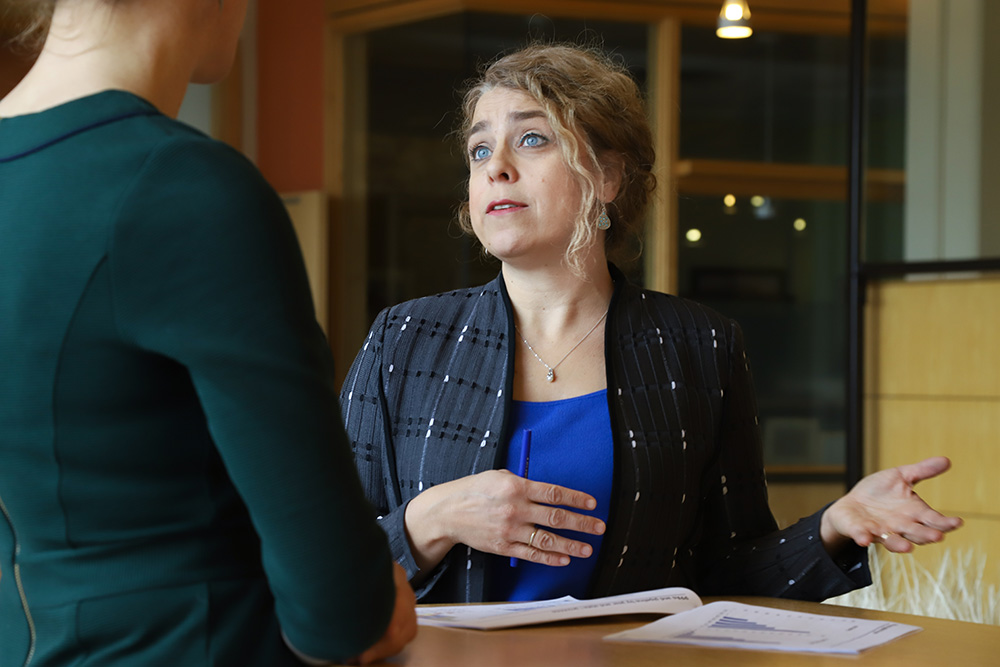
Elizabeth McGeveran says $1 of every $3 McKnight invests goes to advancing its social goals. Photo credit: Molly Miles
The following article was originally published by The Chronicle of Philanthropy on January 8, 2019 as part of a special series of stories on impact investing. It is reprinted here with full permission.
Of the biggest foundations in the United States — the 100 or so with $1 billion or more in assets — none have a deeper commitment to impact investing than the McKnight Foundation.
Ford, to be sure, made a splash in 2017 when it pledged to commit $1 billion to impact investing. But the $1 billion represents less than 9 percent of Ford’s assets, and the foundation says it will take 10 years to allocate that money.
In contrast, McKnight, which has assets of about $2.3 billion, has already committed $187 million to what it calls high-impact investments, intended to further the foundation’s mission to protect the environment and promote social change. Another $637 million is invested in broad-based funds that are in harmony with the foundation’s overall mission and values.
“One out of every three dollars has mission alignment,” says Elizabeth McGeveran, who has led McKnight’s impact-investing program since 2014. No other foundation of McKnight’s size can say that.
This month, McGeveran becomes director of investments at McKnight. Putting her in charge of the entire portfolio will “help us intentionally and opportunistically tilt more of our investments towards greater impact,” says Kate Wolford, McKnight’s president.
The family foundation in Minnesota was established in 1953 by William McKnight and his wife, Maude McKnight. William McKnight spent his entire 59-year career at the 3M Corporation, rising to become CEO and board chair. His descendants are members of the foundation’s board, and fourth-generation family members drove the commitment to impact investing.
“The urgency of the climate issue really pushed us to say we wanted to do more,” Wolford says. McKnight had made program-related investments, mostly in the form of low-cost loans to charities. But, she says, “it takes a different mindset to look at the whole endowment.”
Nimble Operation
McKnight did not have to contend with an in-house investment team, which might have resisted the new approach. (A board committee, with help from a consultant, managed investments.) With the shift, McKnight brought on John Goldstein of Imprint Capital as an adviser. Goldstein says of McKnight: “They are a very fluid, culturally healthy organization of people who work well together. That may not be the case with all large foundations.”
McKnight was also keen to act. “We tried to be thoughtful and do our due diligence, but we wanted to get started,” Wolford says. In 2014, the foundation carved out $200 million for impact investing, about 10 percent of McKnight’s endowment.
“Of the biggest foundations in the United States — the 100 or so with $1 billion or more in assets — none have a deeper commitment to impact investing than the McKnight Foundation.”
Today, McKnight’s endowment includes about two dozen investments for impact, in an array of asset classes: public markets, venture capital, private equity, and PRIs established with charitable intent. Some are classified as “aligned investments,” meaning that they reflect the foundation’s values. They include:
Generation Investment Management. McKnight has invested $157 million in funds managed by Generation, the London-based asset manager founded by former Vice President Al Gore and a Goldman Sachs partner, David Blood. About $125 million has gone into Generation’s Global Equity Fund, which invests in public companies that find “economic opportunities arising from a planet under pressure, capitalizing on trends such as the growth of cities, water scarcity, and the imperative to stop climate change.” The fund has done extremely well. In fact, it has been the best-performing stock fund in McKnight’s entire endowment in the last four years, says McGeveran. Over time, McKnight increased its investment and the fund “graduated” from the impact portfolio to the core endowment, creating more room for other impact investments.
Mellon Capital Management. With a $100 million investment, McKnight persuaded Mellon, one of its longtime endowment managers, to create a broad carbon-efficiency fund that puts fewer investments in carbon-polluting firms and more in companies that are carbon-efficient. (It excludes coal companies but not other fossil-fuel producers.) With about 1,000 holdings, the fund reduces the carbon intensity of its portfolio — measured as greenhouse-gas emissions per dollar of sales — by 53 percent compared with its benchmark, McKnight says. The fund’s financial performance has matched the benchmark.

Midwestern BioAg works with producers to achieve better farming through better soil™. PosiGen helps low-to-moderate income homeowners save on monthly utility bills while generating clean power.
Other funds, referred to as “high-impact investments,” are more directly aligned with McKnight’s programs. They tend to be smaller and riskier than investments in publicly traded stocks or bonds, and are designed to have “near-market financial expectations.” Among them:
G2VP. A venture-capital firm in Silicon Valley, G2VP backs start-up companies that use digital technology to make traditional industries more efficient. Its portfolio companies include Scoop, a corporate-based carpooling app that connects commuters with colleagues, and Proterra, which makes electric buses. McKnight invested $7.5 million.
Midwestern Bio-Ag. This is the exceptional case in which McKnight invested directly in a company, without going through a fund manager or other intermediary. Midwestern Bio-Ag sells an array of products to improve soil, thereby reducing the need for chemical fertilizers. McKnight invested $5 million because the company’s work directly supports a foundation program to restore the water quality and resilience of the Mississippi River.
PosiGen. With an $8 million market-rate loan, McKnight joined a syndicate of investors in supporting this solar-leasing company that serves low-to-moderate income homeowners. PosiGen has demonstrated that it’s possible to build a profitable solar business that can compete with coal-fired power in places such as PosiGen’s home state of Louisiana.
McKnight reports publicly on all its impact investments. “So far, the financial returns have been as good or better than we’d expected,” Wolford says. “There’s no inherent or necessary drag on your endowment.”


